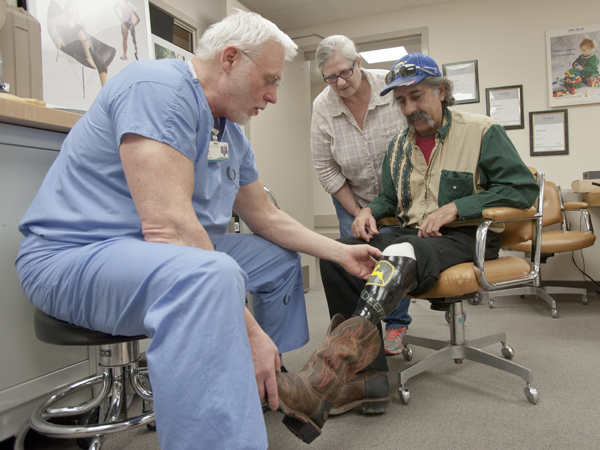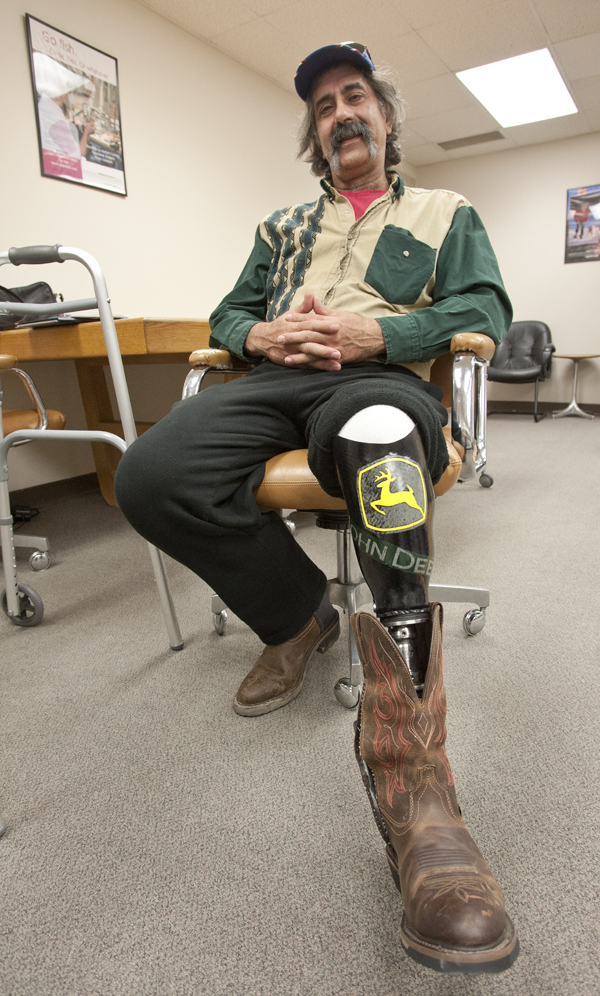Boot-scootin’ on a new leg: Patients travel far for prosthetic expertise

Just minutes after his left leg was all but severed in a farming accident, Albert Hattum says, he accepted the fact he’d probably lose his limb.
What he didn’t accept is that he wouldn’t walk again, drive farm equipment or have a life less full than before his leg was sucked into his John Deere combine after he tried to remove a rock lodged in its blades.
“It was my fault. Being dumb,” Hattum said of the Nov. 7 accident that happened while he was harvesting corn on a 2,500-acre swath of farmland managed by friend Kevin Axtell. Hattum also owns and farms 1,500 acres of corn, soybeans, wheat and small greens in his home of Harrold, S.D.
A little over two months later, Hattum and his wife Vicky drove the 1,200 miles from South Dakota to Jackson, where prosthetic experts at University Rehabilitation Services fitted him with a state-of-the-art lower leg and foot prosthesis they designed and built.
Why choose the University of Mississippi Medical Center, halfway across the country, rather than options at home?
It all has to do with two of Hattum’s farming friends, both amputees. Axtell received a below-the-elbow prosthetic device in Jackson 14 years ago after he slipped and fell into an augur. The other is Gene Melleen, a double amputee whose experience with getting prosthetic legs at home ended badly and left him with no devices more than a decade after his own combine accident.
Vicky Hattum was with her 56-year-old husband when the accident occurred. “To get me out, she called my friend who lost his legs,” Albert Hattum said of Melleen. “He came in his pickup truck.”
More than a dozen friends and family quickly followed. The bones in his leg, Vicky Hattum said, had shattered. “There wasn’t anything to put back together,” she said.
“My dad was there at the time,” Albert Hattum remembered. “I told him, ‘Dad, it’s gone.’ I adjusted to it right there. You’ve got to treat it like a breakdown. Deal with it, and go on.”
Enter Axtell, who 14 years earlier rejected a local prosthetic shop’s suggestion he get a hook to replace his severed hand. He was several hundred miles away the day of Albert Hattum’s accident.
To find a prosthesis, “Kevin and his wife did the research on where to go,” Albert Hattum remembered. “He saw a YouTube video” and soon arrived at the then-private office of Rick Psonak, now assistant professor of orthopedic surgery and certified prosthetist at University Rehabilitation Services (URS). In that office with Psonak was Richard Boleware, now manager of engineering in the Department of Orthopedic Surgery’s Division of Orthotics and Prosthetics.
Axtell was initially fitted at the office of Boleware and Psonak, who shortly after joined the staff at UMMC.
So far, URS has fitted Axtell, who also owns a trucking company, with three additional prostheses, each more sophisticated than the last. His current one incorporates a microprocessor hand so that all the digits move.
“These guys wear them out,” said Psonak, who with prosthetic technician Blake Carr customizes devices for 10 or more amputees per month.
“I talked to them, and I really liked them,” Axtell said of choosing Psonak and Boleware. “Richard and Rick have been very good to me.”

Hattum shows off his John Deere-themed leg
At Axtell’s suggestion, Albert Hattum and his wife arrived at URS Jan. 26. His leg was carefully measured for a prosthesis after he discussed with Psonak and Carr what device would best meet his needs. “He wants to be very active, so we tried him on a foot that articulates (moves in one or more directions) and a carbon fiber vertical shock foot that runners use,” Psonak said. “The carbon foot is made of cutting-edge materials and has the best flexibility and strength. It almost functions as a diving board.”
For Hattum, the choice was clear. “It feels good,” he said of the carbon foot attached to his limb through a socket custom-made by Carr.
He’s had to get creative with Hattum’s carbon foot, Psonak said. An athlete’s prosthetic foot typically is shod in an athletic or walking shoe. Hattum wears cowboy boots, and only cowboy boots. So that the boots can be easily put on, “he’s going to get a zipper put in,” Psonak said.
Five days after he arrived at University Rehabilitation, Hattum walked with a rolling walker, a cane at the ready. “These are the first steps I’ve taken since the accident,” he said. “I’m shooting for a month until I’m walking on my own.”
His special role model is Carr, who lost a lower leg in a four-wheeler accident as a teen. Carr designed the socket on his own PowerWalk BiOM prosthesis with a battery-powered motor that allows him to hunt, play baseball, and do any sport or activity he wants to do.
And if there’s any question about Hattum having the last laugh, Psonak and Carr will put that to rest. His customized prosthesis features a large green and yellow John Deere logo, giving tribute to the only brand of farm equipment Hattum will use. “We went to John Deere and told them we wanted a design. We got a T-shirt and laminated the logo onto the carbon socket,” Psonak said.
The job ahead is to strengthen Hattum’s thigh muscles as he transitions to walking. Psonak and Carr provided a regimen of exercise and education for the Hattums before they departed Jan. 31, and they plan to provide regular checkups and answer questions via Skype.
“For this to work long distance, it takes someone mechanically inclined and who will be compliant and creative in how to help himself,” Psonak said.
Hattum and his family are on a short break before spring planting, but he’s ready to climb back on the combine. “You ever hear of a spring in your step? It’s more my style,” he said of his new limb. “The other leg will get tired, but the new one won’t.”
Hattum, Axtell says, will do just fine.
“He’s stubborn,” Axtell said. “I just hope he isn’t stupid again.”


